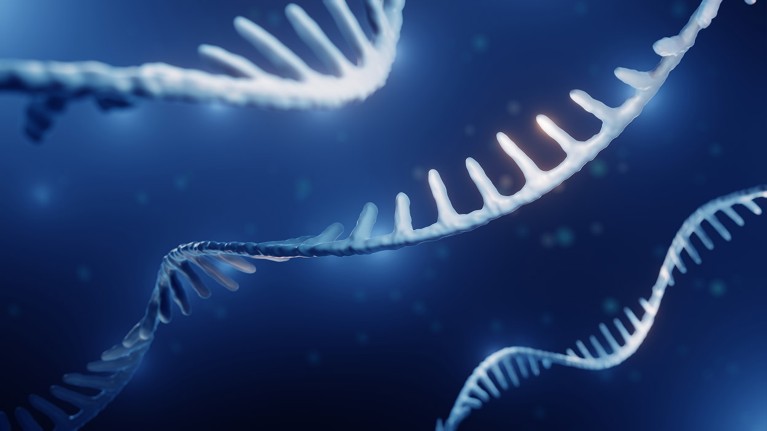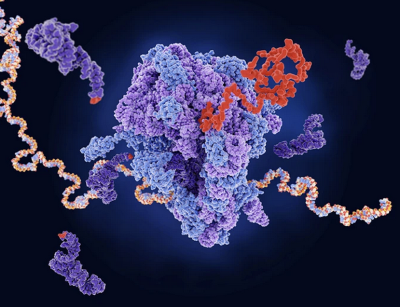Bizarre bacteria defy textbooks by writing new genes

A bacterial enzyme turns biology on its head by reading RNA (artist’s illustration) into DNA that forms new genes.Credit: Artur Plawgo/Science Photo Library
Genetic information usually travels down a one-way street: genes written in DNA serve as the template for making RNA molecules, which are then translated into proteins. That tidy textbook story got a bit complicated in 1970 when scientists discovered that some viruses have enzymes called reverse transcriptases, which scribe RNA into DNA — the reverse of the usual traffic flow.
Now, scientists have discovered an even weirder twist1. A bacterial version of reverse transcriptase reads RNA as a template to make completely new genes written in DNA. These genes are then transcribed back into RNA, which is translated into protective proteins when a bacterium is infected by a virus. By contrast, viral reverse transcriptases don’t make new genes; they merely transfer information from RNA to DNA.
“This is crazy molecular biology,” says Aude Bernheim, a bioinformatician at the Pasteur Institute in Paris, who was not involved in the research. “I would have never guessed this type of mechanism existed.”
One-up on CRISPR
Bacteria fend off viruses and other invaders by deploying myriad defences, such as the juggernaut gene-editing system CRISPR. One of the more mysterious defence systems contains the DNA gene for a reverse transcriptase and a short stretch of mysterious RNA without any clear function: the sequence didn’t seem to encode any protein.
To work out how this system works, a team co-led by molecular biologist Stephen Tang and biochemist Samuel Sternberg, both at Columbia University in New York City, searched for the DNA molecules made by a reverse transcriptase from bacteria called Klebsiella pneumoniae. It found very long DNA sequences that consisted of numerous identical repeating segments. Each segment matched a chunk of the mysterious RNA.
Loop-the-loop
To explain this, the authors note that long RNA strands can form hairpin-like shapes, bringing two distant portions close to each other. The researchers found that the K. pneumoniae reverse transcriptase was doing repeated ‘laps’ around the RNA sequence, which was looped over itself like a shoelace, writing the same RNA molecule into DNA many times over. This created a repetitive DNA sequence.

How scientists are hacking the genetic code to give proteins new powers
The repeated segments created a protein-coding sequence called an open reading frame. The researchers named this sequence neo, for ‘never-ending open reading frame’, because it lacks a sequence that signals the end of a protein and, therefore, theoretically has no limit. They then found that viral infection triggers the production of the Neo protein, which causes cells to stop dividing. The findings, which have not yet been peer reviewed, were posted to the bioRxiv preprint server on 8 May.
How Neo halts growth of infected cells isn’t yet clear, the researchers say. A predicted 3D structure of a portion of Neo — its length probably varies depending on how much of its RNA gets translated — suggests that it forms a series of helices. Experiments showed that breaking up these shapes stymied Neo’s toxic effects. Exactly how viral infection kicks off the creation of the Neo protein is also a mystery, says Bernheim. “This I am burning to know.”
Wonderful life
The discovery that reverse transcriptase — which has previously been known only for copying genetic material — can create completely new genes has left other researchers gobsmacked. “This looks like biology from alien organisms,” Israel Fernandez, a computational chemist at Complutense University of Madrid, wrote on X.
“Their findings were astonishing,” says Nicolás Toro García, a molecular biologist at Zaidín Experimental Research Station, Spanish National Research Council, in Granada, Spain, and should help researchers to develop biotechnology applications for the system.
The discovery has even left Sternberg in awe: “It should change the way we look at the genome.”
doi: https://doi.org/10.1038/d41586-024-01477-8
UPDATES & CORRECTIONS
Correction 23 May 2024: An earlier version of this article included an incorrect city name for Nicolás Toro García and omitted the full name of his institution.
References
Tang, S. et al. Preprint at bioRxiv https://doi.org/10.1101/2024.05.08.593200 (2024).
No comments:
Post a Comment